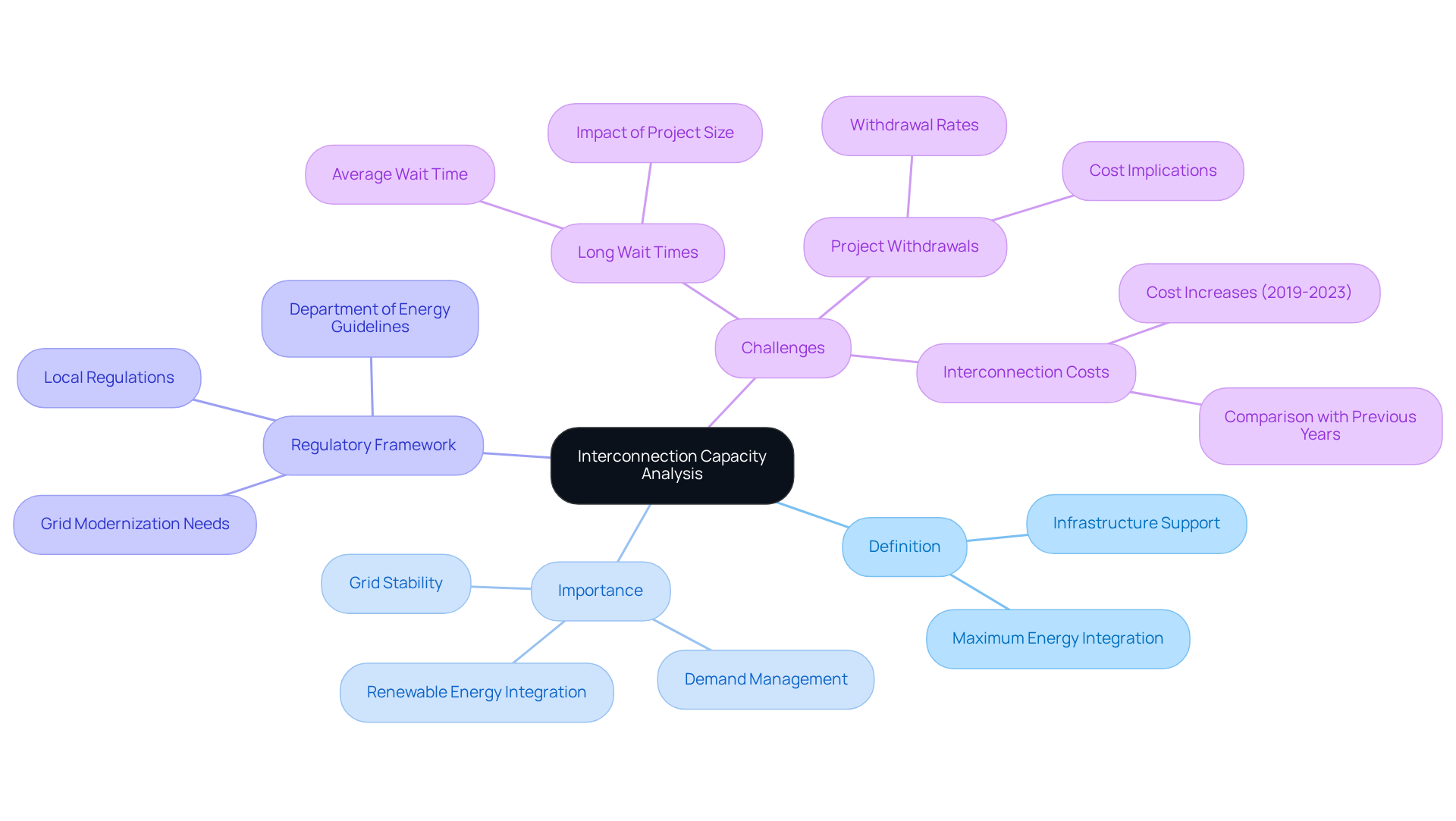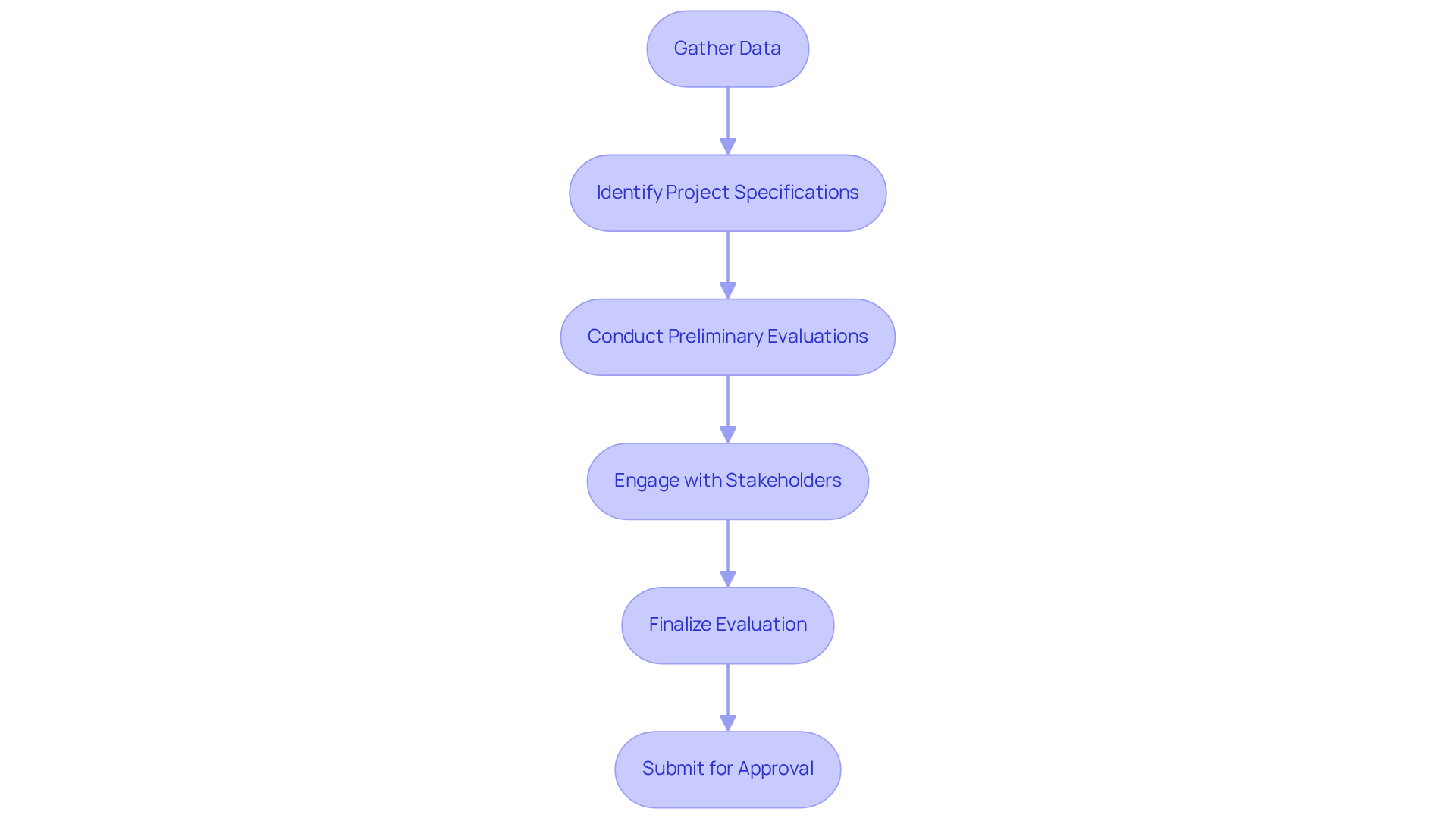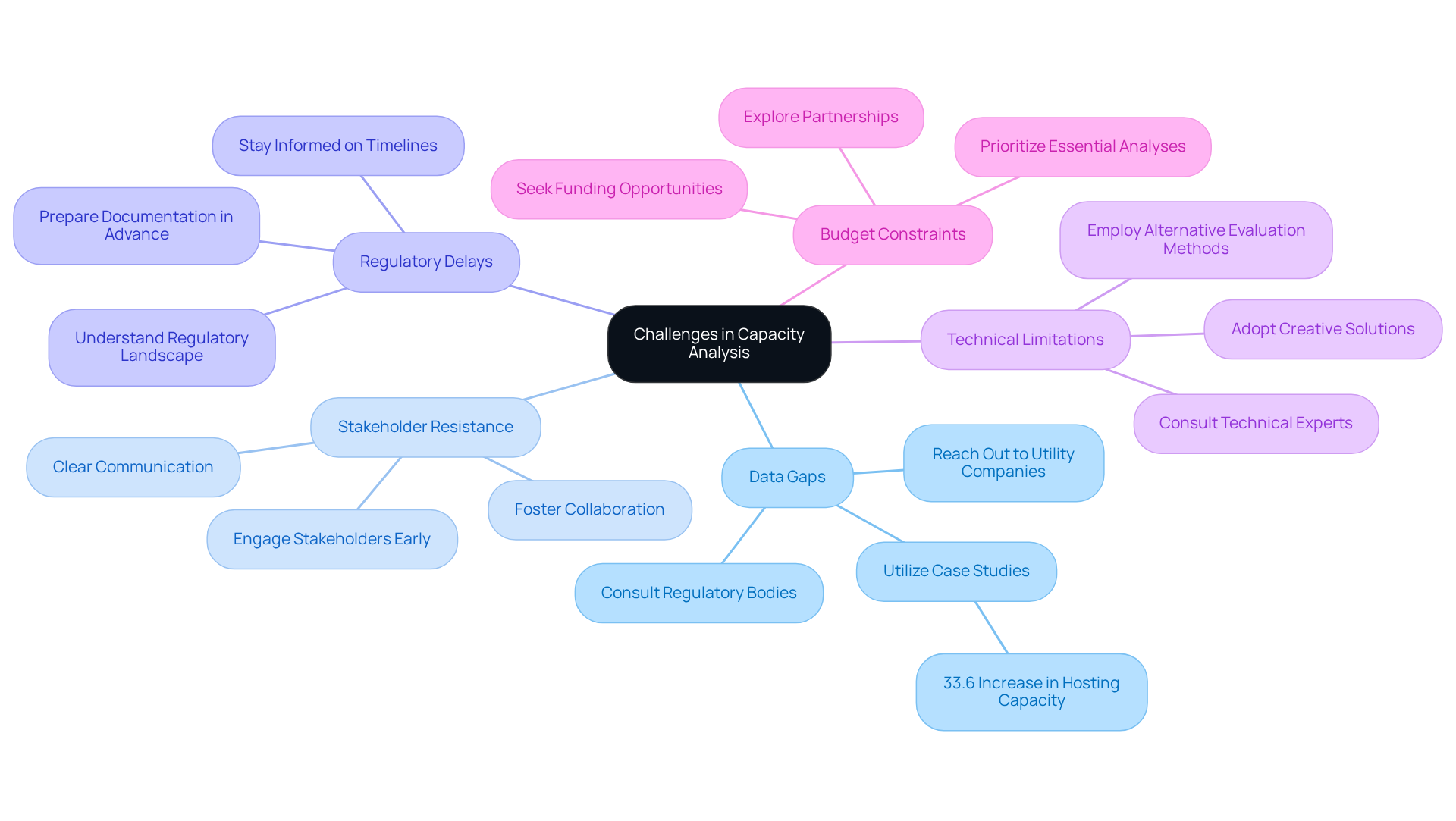Overview
This article serves as a comprehensive guide for conducting interconnection capacity analysis, a critical process for evaluating the electrical network's capacity to incorporate new energy sources. It delineates essential steps, tools, and common challenges associated with this analysis. Emphasizing the necessity of precise data collection, active stakeholder engagement, and strict adherence to regulatory frameworks, the article underscores their vital roles in ensuring the successful integration of renewable energy projects.
Introduction
The increasing demand for renewable energy sources has rendered interconnection capacity analysis an essential element of contemporary electrical infrastructure. This analysis not only evaluates the capability of existing networks to assimilate new energy projects but also guarantees grid reliability in the face of rising loads. As stakeholders confront the intricacies of this analysis, they may find themselves pondering:
- What best practices are necessary to effectively conduct an interconnection capacity analysis?
- What critical steps should be taken to navigate the common challenges that emerge?
Understand Interconnection Capacity Analysis
Interconnection potential analysis is vital for evaluating the electrical network's capacity to integrate new energy sources, such as solar and wind power. This process determines whether the existing infrastructure can support additional loads without sacrificing reliability. Key components include:
- Definition: Interconnection capacity is defined as the maximum amount of energy that can be safely integrated into the grid from new generation sources. This capability is crucial for ensuring that the network can handle increased demand, particularly as renewable energy initiatives proliferate.
- Importance: The analysis is essential for maintaining grid stability and reliability while enabling the integration of new energy projects. With renewables now leading new power generation capacity in the U.S., comprehending interconnection potential is more critical than ever. In 2024 alone, solar installations contributed an estimated 39.6 gigawatts (GW) of power, highlighting the necessity for robust interconnection frameworks.
- Regulatory Framework: Understanding local regulations and standards governing interconnection processes is crucial, as these can differ significantly by region. The Department of Energy has underscored the urgent need for grid modernization to accommodate rising load growth, especially given the increasing demand from data centers and electrification efforts. The U.S. clean energy sector is at a pivotal moment following record-breaking years in solar deployment and electric vehicle sales, emphasizing the urgency of addressing these challenges.
Understanding these elements empowers stakeholders to effectively navigate the complexities of interconnection capacity analysis. For example, case studies reveal that only 20% of interconnection initiatives from 2000 to 2018 became operational by the end of 2023, underscoring the challenges faced in completion. Moreover, the average wait time for renewable energy initiatives in the interconnection queue has escalated to five years, with larger projects experiencing even longer delays, as the average duration from interconnection request to online operation increases with project size. This further underscores the importance of prompt and precise evaluation in facilitating successful project integration.

Follow Step-by-Step Procedures for Capacity Analysis
To effectively conduct an interconnection capacity analysis, it is crucial to follow these steps:
- Gather Data: Begin by collecting essential information on existing network infrastructure, including load profiles, generation potential, and historical performance metrics. Leveraging Harbinger Land's GIS modeling services can significantly enhance data gathering by providing a comprehensive spatial evaluation of the network's existing capabilities.
- Identify Project Specifications: Clearly define the details of the new energy initiative, outlining anticipated generation potential and operational features. This clarity is vital as it directs the evaluation process and can be further supported by GIS tools to illustrate impacts on the network.
- Conduct Preliminary Evaluations: Utilize advanced software tools to perform initial evaluations of the network's capacity to accommodate the new project. This may include load flow studies and stability evaluations, where GIS modeling can assist in identifying potential bottlenecks and enhancing integration strategies.
- Engage with Stakeholders: Collaborate with utility companies, regulatory bodies, and other stakeholders to discuss findings and gather feedback. Effective stakeholder engagement is essential for addressing concerns and ensuring alignment with regulatory expectations. By leveraging Harbinger Land's expertise in site and right-of-way acquisitions, particularly through GIS modeling, this process can be streamlined by identifying optimal easements and minimizing delays.
- Finalize Evaluation: Compile the results into a comprehensive report that outlines the capacity assessment, highlighting any necessary upgrades or modifications to the grid. Utilizing Harbinger Land's GIS mapping and title research services can enhance the efficiency of land rights acquisition, ensuring informed decision-making and actionable recommendations.
- Submit for Approval: Present the evaluation to relevant authorities for review and endorsement, ensuring compliance with all regulatory requirements. This step is critical for progressing with the initiative and obtaining necessary permits.
By adhering to these steps, stakeholders can ensure a thorough and effective interconnection capacity analysis, facilitating the seamless integration of new energy projects into the current network infrastructure.

Utilize Essential Tools and Resources for Analysis
To effectively conduct an interconnection capacity analysis, it is essential to leverage the following tools and resources:
- GIS Mapping Software: Geographic Information Systems (GIS) serve as a powerful tool to visualize the grid layout and identify potential interconnection points, facilitating informed decision-making.
- Load Flow Analysis Tools: Utilizing software such as PSS/E or PowerWorld allows for the simulation of grid responses to new loads and generation sources, providing critical insights into system behavior.
- Data Management Systems: Implementing robust databases enables the storage and analysis of historical performance data, which is crucial for assessing resource viability and enhancing operational efficiency.
- Regulatory Guidelines: It is imperative to reference documents from local regulatory bodies, as they outline interconnection standards and requirements that must be adhered to.
- Collaboration Platforms: Employing project management tools enhances communication and cooperation among stakeholders, ensuring a streamlined evaluation process that addresses all concerns effectively.
Troubleshoot Common Challenges in Capacity Analysis
During the interconnection capacity analysis, several challenges may arise. Understanding these common issues and how to address them is crucial for success.
- Data Gaps: Missing or incomplete data can hinder progress. Reach out to utility companies or regulatory bodies for assistance in obtaining the necessary information. Case studies, such as one that achieved a 33.6% increase in hosting capacity through demand management, provide valuable insights into effective practices.
- Stakeholder Resistance: Engaging stakeholders early in the process is vital to address concerns and foster collaboration. Clear communication can significantly mitigate resistance. As noted by McKenna Peplinski, early involvement often leads to greater stakeholder engagement success rates, ultimately enabling smoother execution of projects.
- Regulatory Delays: Staying informed about regulatory timelines and requirements is essential. Prepare all necessary documentation in advance to avoid delays in the approval process. Insights from experts indicate that a thorough understanding of the regulatory landscape, alongside an interconnection capacity analysis, can streamline approvals and enhance project timelines, which is crucial given the estimated $24 billion net cost of delays in building power infrastructure.
- Technical Limitations: If software tools fail to deliver precise results, consulting with technical experts or employing alternative evaluation methods may be necessary. Case studies highlight instances where organizations embraced creative methods to tackle technical challenges, resulting in enhanced evaluation outcomes.
- Budget Constraints: When costs exceed expectations, prioritize essential analyses and seek funding opportunities or partnerships to support the project. Strategies employed by other organizations in similar situations can serve as a guide for effective budget management and resource allocation.

Conclusion
Interconnection capacity analysis is essential for ensuring that electrical networks can effectively accommodate the increasing influx of renewable energy sources. By evaluating the existing infrastructure's capability to integrate new projects, stakeholders can uphold grid reliability while facilitating the transition to cleaner energy. This comprehensive understanding is critical as the demand for renewable energy continues to escalate, rendering effective analysis not merely advantageous but imperative.
This article delineates a systematic approach to conducting interconnection capacity analysis, highlighting the necessity of gathering precise data, engaging with stakeholders, and employing advanced tools. Key steps encompass:
- Defining project specifications
- Executing preliminary evaluations
- Navigating regulatory frameworks
Furthermore, addressing prevalent challenges—such as data gaps, stakeholder resistance, and technical limitations—is vital for the successful integration of projects.
Ultimately, mastering interconnection capacity analysis empowers stakeholders with the knowledge and tools required to ensure the seamless incorporation of renewable energy initiatives into existing grids. As the energy landscape evolves, adopting these best practices and methodologies will enable organizations to contribute effectively to a sustainable energy future, ensuring that the infrastructure can meet the demands of tomorrow. Engaging in proactive analysis and collaboration will not only enhance project success rates but also support the broader objective of achieving a reliable, resilient, and clean energy grid.
Frequently Asked Questions
What is interconnection capacity analysis?
Interconnection capacity analysis evaluates the electrical network's ability to integrate new energy sources, such as solar and wind power, determining if the existing infrastructure can support additional loads without compromising reliability.
What does interconnection capacity refer to?
Interconnection capacity is defined as the maximum amount of energy that can be safely integrated into the grid from new generation sources, which is essential for accommodating increased demand, especially from renewable energy initiatives.
Why is interconnection capacity analysis important?
It is crucial for maintaining grid stability and reliability while facilitating the integration of new energy projects, particularly as renewable energy sources have become the leading contributors to new power generation capacity in the U.S.
What role do local regulations play in interconnection capacity analysis?
Local regulations and standards governing interconnection processes vary significantly by region, making it essential to understand these rules to navigate the complexities of interconnection capacity effectively.
What challenges are currently faced in interconnection initiatives?
Only 20% of interconnection initiatives from 2000 to 2018 became operational by the end of 2023, and the average wait time for renewable energy projects in the interconnection queue has increased to five years, with larger projects experiencing even longer delays.
How has the demand for renewable energy impacted interconnection capacity?
The rising demand from data centers and electrification efforts, along with record-breaking solar deployment and electric vehicle sales, has highlighted the urgent need for grid modernization to accommodate increased load growth.
List of Sources
- Understand Interconnection Capacity Analysis
- U.S. cumulative capacity in interconnection queues 2022| Statista (https://statista.com/statistics/1305949/cumulative-capacity-interconnection-queues-united-states)
- US Clean Power Development Sees Record Progress, As Well As Stronger Headwinds (https://wri.org/insights/clean-energy-progress-united-states)
- The US interconnection queue is twice its installed capacity (https://latitudemedia.com/news/the-us-interconnection-queue-is-twice-its-installed-capacity)
- US Interconnection Queues Analysis 2023 (https://spglobal.com/market-intelligence/en/news-insights/research/us-interconnection-queues-analysis-2023)
- Backlog of Generation, Energy Storage Interconnection Requests Grew in 2023 | American Public Power Association (https://publicpower.org/periodical/article/backlog-generation-energy-storage-interconnection-requests-grew-2023)
- Follow Step-by-Step Procedures for Capacity Analysis
- Where's the Value in Hosting Capacity Analysis? (https://icf.com/insights/energy/hosting-capacity-analysis)
- Hosting capacity analysis could simplify grid interconnection for distributed energy resources (https://renewableenergyworld.com/power-grid/hosting-capacity-analysis-could-simplify-grid-interconnection-for-distributed-energy-resources)
- Understanding the DER Interconnection Process: A Comprehensive Guide - Bimergen Energy (https://bitech.tech/knowledge-hub/320241022/understanding-the-der-interconnection-process:-a-comprehensive-guide)
- Hosting Capacity Analysis Hosting Capacity Analysis (https://irecusa.org/our-work/hosting-capacity-analysis)
- Electricity generation, capacity, and sales in the United States - U.S. Energy Information Administration (EIA) (https://eia.gov/energyexplained/electricity/electricity-in-the-us-generation-capacity-and-sales.php)
- Utilize Essential Tools and Resources for Analysis
- Power System Analysis Software Market Size by 2032 (https://coherentmarketinsights.com/market-insight/power-system-analysis-software-market-3937)
- 6 Best GIS Software 2025 (https://caliper.com/maptitude/blog/6-best-gis-software/default.htm?srsltid=AfmBOopm2HLey2ieQdfpHE_qWewU-pw68-ssOA2nsUoC3Gp42X1ELmus)
- Quotes to Note | Landsat Science (https://landsat.gsfc.nasa.gov/news/quotes-to-note)
- Best GIS Software with Monitoring 2025 (https://getapp.com/business-intelligence-analytics-software/gis/f/monitoring)
- bookey.app (https://bookey.app/quote-author/jack-dangermond)
- Troubleshoot Common Challenges in Capacity Analysis
- Artificial Intelligence for Hosting Capacity Analysis: A Systematic Literature Review (https://mdpi.com/1996-1073/16/4/1864)
- Optimizing Grid Interconnection Hosting Capacity Analysis (https://simplethread.com/case_study/optimizing-grid-interconnection-hosting-capacity-analysis)
- Power Delayed: The Hidden Costs of Postponing Power Projects, with McKenna Peplinski (https://resources.org/resources-radio/power-delayed-the-hidden-costs-of-postponing-power-projects-with-mckenna-peplinski)
- PJM Market Challenges Demand Bold Reforms, Experts Warn (https://powermag.com/pjm-market-challenges-demand-bold-reforms-experts-warn)
- CaliforniaDGStats (https://californiadgstats.ca.gov/downloads)




